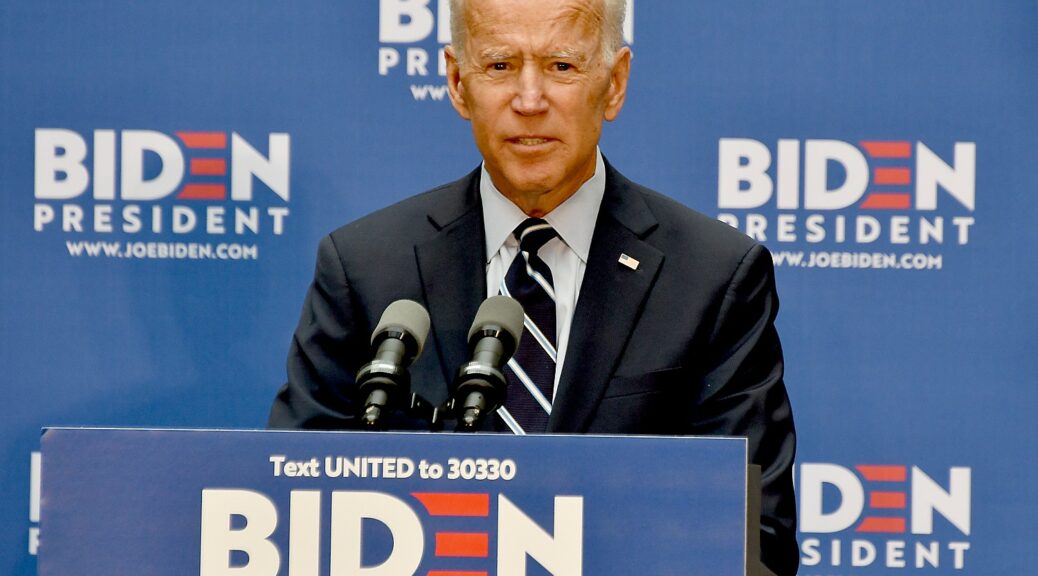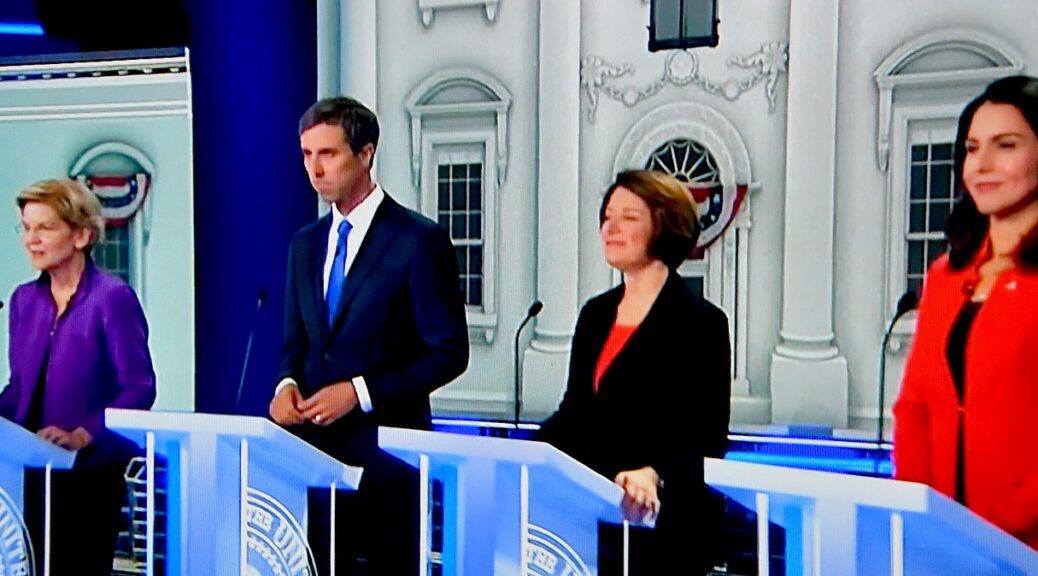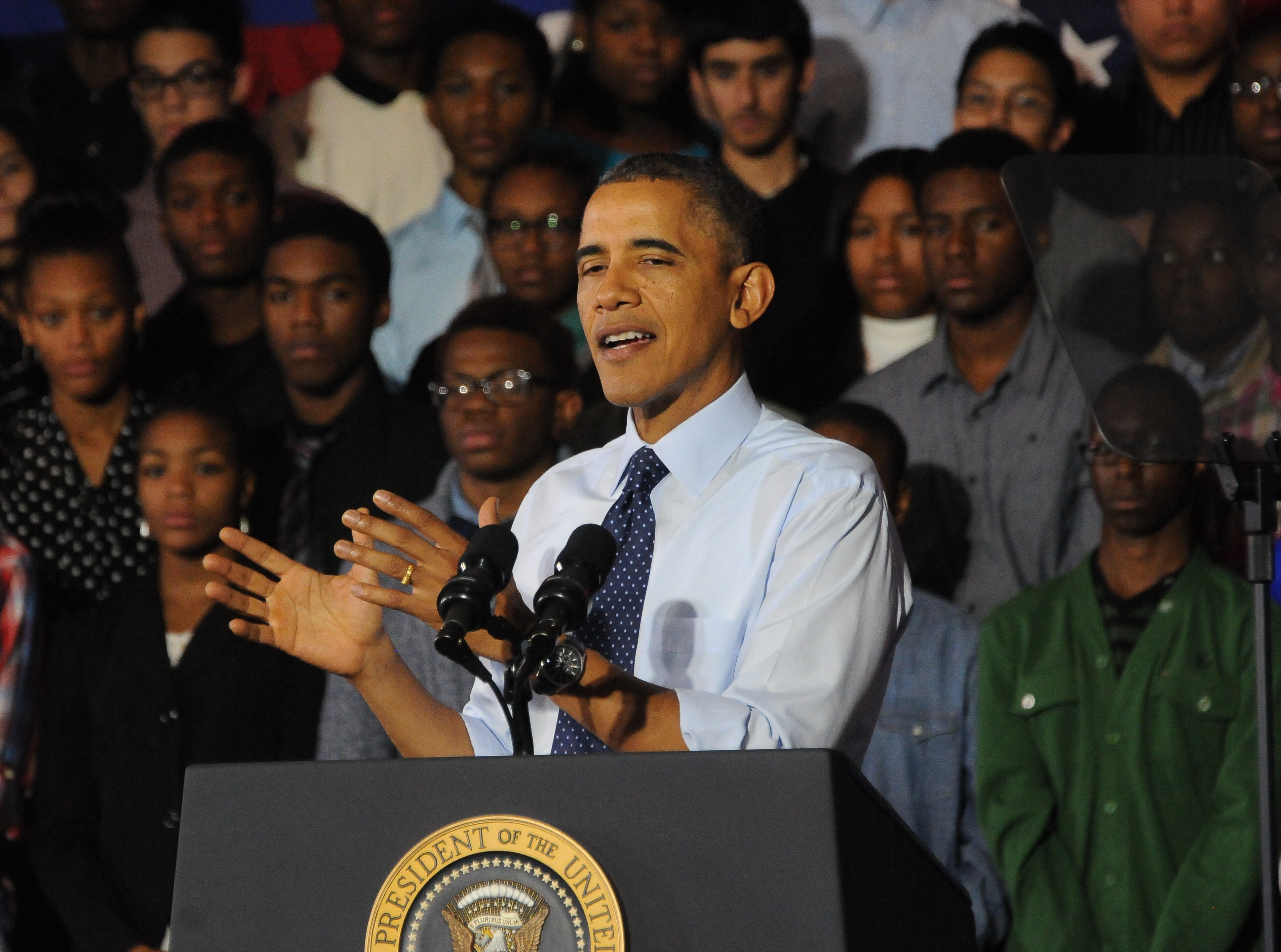
The
vigorous contest of Democrats seeking the 2020 presidential nomination has
produced excellent policy proposals to address major issues. In a recent poll,
Americans have indicated that education is a top issue. Vice President
Joe Biden has announced a detailed plan for education
beyond high school in order to build a stronger, more inclusive
middle class. This is from the Biden campaign:
For many, earning a bachelor’s degree, associate’s degree, or other credential
after high school is unaffordable or saddles them with so much debt it prevents
them from buying a home, saving for retirement. Or, it puts financial stress on
their parents and grandparents. In an increasingly globalized and
technology-driven economy, 12 years of education is no longer enough for
American workers to remain competitive and earn a good income. While 6 in 10
jobs require some education after high school, not all require a bachelor’s degree.
Biden is proposing a bold plan for education and training beyond high school
that will give hard-working Americans the chance to join or maintain their
place in the middle class, regardless of their parents’ income or the color of
their skin. Four years of college shouldn’t be the only path to the middle
class. Biden’s plan ensures every child in the U.S. can afford the path that
makes sense for them – whether its an industry credential, associate’s degree,
or bachelor’s degree. Coupled with his proposals to make sure there are quality
jobs ready for our workers, Biden is putting forward a bold plan to rebuild the
backbone of our country – the middle class – and this time make sure everyone
has the chance to come along.
As president, Biden will:
- Invest in community colleges and training to improve student success and grow a stronger, more prosperous, and more inclusive middle class.
- Strengthen college education as the reliable pathway to the middle class, not an investment that provides limited returns and leaves graduates with mountains of debt they can’t afford.
- Support colleges and universities that play unique and vital roles in their communities, including Historically Black Colleges and Universities and Minority-Serving Institutions.
Earlier this
week, the campaign announced Women for Biden, highlighting how Trump’s
administration has turned its back on women. The Trump Administration’s failure
to deal with the student debt crisis is a perfect example. Women hold two
thirds of the nation’s $1.5 trillion student debt. Instead of reducing the debt
burden or expanding educational opportunities for women, Trump’s administration
– with Secretary Betsy DeVos leading the U.S. Department of Education – has
worked to cut access to education and sided with for-profit colleges and loan
companies over students and graduates.
Biden’s plan builds on his and Dr. Biden’s work to give hard working Americans
access to two years of community college without debt. A majority of community
college students are women and face unique barriers to completing their
degrees. Biden will expand these students’ access to needed services like child
care, and ensure that Pell Grants can be used for other costs like housing and
books.
This plan builds on Vice President Biden’s comprehensive plan to invest in our children’s
education from birth through 12th grade. And, in the months ahead, Biden will
also outline in further detail his proposals to make sure there are quality
jobs ready for our workers.
FACT SHEET:
THE BIDEN PLAN FOR EDUCATION BEYOND HIGH SCHOOL
Joe Biden is
running for president to rebuild the backbone of the United States – the middle
class – and this time make sure everyone has a chance to come along. In
today’s increasingly globalized and technology-driven economy, 12 years of
education is no longer enough for American workers to remain competitive and
earn a middle class income. Roughly 6 in 10
jobs require
some education beyond a high school diploma. And, because technology continues
to change, American workers – whether they have an industry-recognized
credential, an associate’s degree, a bachelor’s degree, or a PhD – will need
opportunities to continue to learn and grow their skills for career success and
increased wages in the 21st century economy.
But for too many, earning a degree or other credential after high school is
unaffordable today. For others, their education saddles them with so much debt
it prevents them from buying a home or saving for retirement, or their parents
or grandparents take on some of the financial burden.
Biden is proposing a bold plan for education and training beyond high school
that will give hard-working Americans the chance to join or maintain their
place in the middle class, regardless of their parents’ income or the color of
their skin. President Biden will:
Invest in community colleges and training to improve student success and grow a stronger, more prosperous, and more inclusive middle class.
Strengthen college as the reliable pathway to the middle class, not an investment that provides limited returns and leaves graduates with mountains of debt they can’t afford.
Support colleges and universities that play unique and vital roles in their communities, including Historically Black Colleges and Universities and Minority-Serving Institutions.
All of these
proposals will be implemented in partnership with states as well as school
faculty and staff. Educators must play a key role in decisions affecting
teaching and learning.
Of course, increasing the quality and affordability of post-secondary education
system alone is not enough to make sure our middle class succeeds. This plan
builds on Vice President Biden’s comprehensive plan to invest in our children’s
education from birth through 12th grade. And, in the months ahead, Biden will
also outline in further detail his proposals to make sure there are quality
jobs ready for our workers.
INVEST IN COMMUNITY COLLEGES AND
TRAINING TO IMPROVE STUDENT SUCCESS AND GROW A STRONGER, MORE PROSPEROUS, AND
MORE INCLUSIVE MIDDLE CLASS
Dr. Jill Biden, a current community college professor, refers to community
colleges as America’s best kept secret. They are a proven, high-quality tool
for providing hard-working Americans access to education and skills and a
pathway to the middle class. In fact, today in the United States there
are an estimated 30
million quality jobs,
with an average salary of $55,000, that don’t require a bachelor’s degree.
Every year, millions of Americans attend community
colleges to get the credentials they need to obtain these jobs. And, community
colleges offer affordable, quality ways for students to complete the first two
years of a four-year degree.
Part of what makes community colleges so extraordinary is that, working with
limited resources, they have figured out how to provide a high-quality,
cost-effective education to students often juggling additional
responsibilities, such as jobs or child care. But as a country, we haven’t
invested enough in making sure community colleges can reach all the Americans
who could benefit from their programs, or improve their quality and completion
rates.
The Biden Administration will build on community colleges’ success and unleash
their full potential to grow a stronger, more inclusive middle class by:
Providing two years of community college or other high-quality training program without debt for any hard-working individual looking to learn and improve their skills to keep up with the changing nature of work. In 2015, President Obama and Vice President Biden proposed to make two years of community college tuition-free for hard-working students. Since then, Vice President Biden and Dr. Biden have championed progress toward this goal, and hundreds of state and local College Promise programs have expanded access to free two-year or four-year college educations. As president, Biden will build on this progress by enacting legislation to ensure that every hard-working individual, including those attending school part-time and DREAMers (young adults who came to U.S. as children), can go to community college for up to two years without having to pay tuition. Individuals will also be able to use these funds to pursue training programs that have a track record of participants completing their programs and securing good jobs. Importantly, this initiative will not just be for recent high school graduates; it will also be available to adults who never had the chance to pursue additional education beyond high school or who need to learn new skills. And, students who do want a bachelor’s degree could then transfer to a four-year school, including to Historically Black Colleges and Universities and Minority-Serving Institutions that play vital roles in their communities. This plan will be a federal-state partnership, with the federal government covering 75% of the cost and states contributing the remaining obligation. The federal government will cover up to 95% of the cost for Indian Tribes operating community colleges serving low-income students.
Creating a new grant program to assist community colleges in improving their students’ success. The Biden Administration will support community colleges implementing evidence-based practices and innovative solutions to increase their students’ retention and completion of credentials. Reforms could include academic and career advising services; dual enrollment; credit articulation agreements; investing in wages, benefits, and professional development to recruit and retain faculty, including teacher residencies; and improvements to remediation programs. The Biden plan will also help community colleges around the country scale successful programs to help a larger number of students.
Tackling the barriers that prevent students from completing their community college degree or training credential. There are too many Americans who don’t complete their education or training programs not because of a lack of will, but because of other responsibilities they are juggling, such as a job to pay their bills or caring for children. Often these students and their families also face housing and food insecurity. The Biden Administration’s community college initiative will be a first-dollar program, meaning that students will be able to use their Pell grants, state aid, and other aid to help them cover expenses beyond tuition and fees. In addition, the Biden plan will give states financial incentives to foster collaboration between community colleges and community-based organizations to provide wraparound support services for students, especially veterans, single parents, low-income students, students of color, and students with disabilities who may face unique challenges. Wraparound support services can range from public benefits and additional financial aid to cover textbook and transportation costs that often keep students from staying enrolled, to child care and mental health services, faculty mentoring, tutoring, and peer support groups. And, Biden will establish a federal grant program to help community colleges create emergency grant programs for students who experience an unexpected financial challenge that threatens their ability to stay enrolled.
Make a $50 billion investment in workforce training, including community-college business partnerships and apprenticeships. In 2014, President Obama asked Vice President Biden to develop a national strategy for reforming our nation’s workforce training programs designed to prepare “ready-to-work Americans with ready-to-be-filled jobs.” Building on the successful models championed through that initiative, President Biden will make an investment of $50 billion in high-quality training programs. These funds will create and support partnerships between community colleges, businesses, unions, state, local, and tribal governments, universities, and high schools to identify in-demand knowledge and skills in a community and develop or modernize training programs – which could be as short as a few months or as long as two years – that lead to a relevant, high-demand industry-recognized credential. These funds will also exponentially increase the number of apprenticeships in this country through strengthening the Registered Apprenticeship Program and partnering with unions who oversee some of the best apprenticeship programs throughout our nation, not watering down the quality of the apprenticeship system like President Trump is proposing.
Invest in community college facilities and technology. Biden will invest $8 billion to help community colleges improve the health and safety of their facilities, and equip their schools with new technology that will empower their students to succeed in the 21st century.
STRENGTHEN
COLLEGE AS A RELIABLE PATHWAY TO THE MIDDLE CLASS
We have a student debt crisis in this country, with roughly more than 44 million American individuals now
holding a total of $1.5 trillion in student loans. One in five adults who hold student loans
are behind on payments, a disproportionate
number of whom are black. Thus, student debt both exacerbates and results from racial wealth
gap.
This challenge is also intergenerational. Almost one in ten Americans in their 40s and 50s
still hold student loan debt. But, college debt has especially
impacted Millennials who
pursued educational opportunities during the height of the Great Recession and
now struggle to pay down their student loans instead of buying a house, opening
their own business, or setting money aside for retirement.
There are several drivers of this problem. The cost of higher education has
skyrocketed, roughly
doubling since
the mid-1990s. States have dramatically decreased investments in higher education, leaving
students and their families with the bill. And, too often individuals have been
swindled into paying for credentials that don’t provide value to graduates in
the job market. As president, Biden will address all of these challenges.
Biden’s plan to make two years of community college without debt will
immediately offer individuals a way to become work-ready with a two-year degree
or an industry certification. It will also halve their tuition costs for
obtaining a four-year degree, by earning an associate’s degree and then
transferring those credits to a four-year college or university. And, as a
federal-state partnership, it will ensure states both invest in community
colleges and give states some flexibility to also invest in college readiness
or affordability at four-year institutions. In addition, President Biden will:
Target additional financial support to low-income and middle-class individuals by doubling the maximum value of Pell grants, significantly increasing the number of middle-class Americans who can participate in the program. Pell grants help 7 million students a year afford college, but they have not kept up with the rising cost of college. In the 1970s, Pell grants covered roughly 70 to 80 percent of the cost of a four-year degree at a public institution; today, that percentage has been cut in more than half, to roughly 30 percent. Biden will double the maximum value of the Pell grant, a level of investment experts say is necessary to close the gap between the rich and poor so that everyone has the opportunity to receive an education beyond high school, and will automatically increase the value based on inflation. Doubling the maximum value of Pell grants will increase the grant value for individuals already eligible for Pell and, given the program’s formula for determining eligibility, expand the benefits of Pell to more middle class Americans. As president, Biden will also take care of young immigrants by ensuring DREAMers are eligible for financial aid if they meet other requirements for that aid. And, he will restore formerly incarcerated individuals’ eligibility for Pell.
More than halve payments on undergraduate federal student loans by simplifying and increasing the generosity of today’s income-based repayment program. Under the Biden plan, individuals making $25,000 or less per year will not owe any payments on their undergraduate federal student loans and also won’t accrue any interest on those loans. Everyone else will pay 5% of their discretionary income (income minus taxes and essential spending like housing and food) over $25,000 toward their loans. This plan will save millions of Americans thousands of dollars a year. After 20 years, the remainder of the loans for people who have responsibly made payments through the program will be 100% forgiven. Individuals with new and existing loans will all be automatically enrolled in the income-based repayment program, with the opportunity to opt out if they wish. In addition to relieving some of the burden of student debt, this will enable graduates to pursue careers in public service and other fields without high levels of compensation. Biden will also change the tax code so that debt forgiven through the income-based repayment plan won’t be taxed. Americans shouldn’t have to take out a loan to pay their taxes when they finally are free from their student loans.
Make loan forgiveness work for public servants. Public servants do the hard work that is essential to our country’s success – protecting us, teaching our children, keeping our streets clean and our lights on, and so much more. But the program designed to help these individuals serve without having to worry about the burden of their student loans – the Public Service Loan Forgiveness Program – is broken. Biden will create a new, simple program which offers $10,000 of undergraduate or graduate student debt relief for every year of national or community service, up to five years. Individuals working in schools, government, and other non-profit settings will be automatically enrolled in this forgiveness program; up to five years of prior national or community service will also qualify. Additionally, Biden will fix the existing Public Service Loan Forgiveness program by securing passage of the What You Can Do For Your Country Act of 2019. Biden will ensure adjunct professors are eligible for this loan forgiveness, depending on the amount of time devoted to teaching.
Create a “Title I for postsecondary education” to help students at under-resourced four-year schools complete their degrees. The Biden Administration will establish a new grant program to support under-resourced four-year schools that serve large numbers of Pell-eligible students. The funds will be used to foster collaboration between colleges and community-based organizations to provide wraparound support services for students, especially veterans, single parents, low-income students, students of color, and students with disabilities who may face unique challenges. Wraparound support services can range from public benefits and additional financial aid to cover textbook and transportation costs that often keep students from staying enrolled, to child care and mental health services, faculty mentoring, tutoring, and peer support groups. And, Biden will ensure that these funds can be used to help colleges create emergency grant programs for students who experience an unexpected financial challenge that threatens their ability to stay enrolled.
Create seamless pathways between high school, job training, community college, and four-year programs to help students get their degrees and credentials faster. The Biden Administration will provide grants to states that work to accelerate students’ attainment of credentials, including bachelor’s degrees, while still ensuring quality and accountability. For example, some communities have adopted the early college model, allowing students to begin earning credits towards an associate’s degree while still in high school. And, in some areas students can be dual enrolled in the community college and the four-year program they wish to complete. Biden will challenge more communities to expand on these accelerated pathways and create a seamless transition between high school, community college, other job training, and four-year programs, enabling students to obtain an associate’s or bachelor’s degree in less time. Approaches to accelerating degree attainment include guided pathways that provide a sequence of classes for a specific area of study; shifting toward a 12-month academic calendar; better aligning high school, community college, and four-year college courses; providing college credits for quality, degree-related on-the-job training; and offering degree-related paid internships for course credit. Read more about Joe Biden’s plan for education from birth through 12th grade here.
Prioritize the use of work-study funds for job-related and public service roles. Biden will work to reform federal work study programs to ensure that more of these funds place students in roles where they are either learning skills valuable for their intended careers, or contributing to their communities by mentoring students in K-12 classrooms and community centers.
Stop for-profit education programs from profiteering off of students. Students who started their education at for-profit colleges default on their student loans at a rate three times higher than those who start at non-profit colleges. These for-profit programs are often predatory – devoted to high-pressure and misleading recruiting practices and charging higher costs for lower quality education that leaves graduates with mountains of debt and without good job opportunities. The Biden Administration will require for-profits to first prove their value to the U.S. Department of Education before gaining eligibility for federal aid. The Biden Administration will also return to the Obama-Biden Borrower’s Defense Rule, forgiving the debt held by individuals who were deceived by the worst for-profit college or career profiteers. Finally, President Biden will enact legislation eliminating the so-called 90/10 loophole that gives for-profit schools an incentive to enroll veterans and servicemembers in programs that aren’t delivering results.
Crack down on private lenders profiteering off of students and allow individuals holding private loans to discharge them in bankruptcy. In 2015, the Obama-Biden Administration called for Congress to pass a law permitting the discharge of private student loans in bankruptcy. As president, Biden will enact this legislation. In addition, the Biden Administration will empower the Consumer Financial Protection Bureau – established during the Obama-Biden Administration – to take action against private lenders who are misleading students about their options and do not provide an affordable payment plan when individuals are experiencing acute periods of financial hardship.
Support and protect post-9/11 GI benefits for veterans and qualified family members. Veterans and their family members served our country and as a nation, we must maintain our commitment to GI benefits. The Obama-Biden Administration took groundbreaking action to ensure that veterans and their family members were empowered to make informed decisions regarding their education and, in turn, ensure that programs educating them met high quality standards. President Biden will build and convene coalitions of experts and advocates to continue this work. He’ll also strengthen the GI Bill Comparison Tool and School Feedback Tool to put an end to post-secondary institutions’ predatory practices.
SUPPORT
COLLEGES AND UNIVERSITIES THAT PLAY UNIQUE AND VITAL ROLES IN THEIR COMMUNITIES
Historically Black Colleges and Universities (HBCUs), Tribal Colleges And
Universities (TCUs), Hispanic-serving Institutions (HSIs), Asian American And
Native American Pacific Islander-serving Institutions (AANAPISIs), Alaska
Native-serving Institutions and Native Hawaiian-serving Institutions (ANNHs),
Predominantly Black Institutions (PBIs), and Native American-serving Nontribal
Institutions (NASNTIs) serve a disproportionate number of students of color and
low-income students, yet are severely under-resourced, especially when compared
to other colleges and universities.
This makes HBCUs and MSIs’ contributions even more impressive. HBCUs, for
example, disproportionately educate first-generation and
low-income students. In Vice President Biden’s home state of Delaware, the HBCU
Delaware State University graduates
nearly half of the state’s black undergraduate students.
As president, Biden will take steps to rectify the funding disparities faced by
HBCUs, TCUs, and Minority-Serving Institutions (MSIs) so that the United States
can benefit from their unique strengths. Students at HBCUs, TCUs, and MSIs will
benefit from Biden’s proposals to double Pell grants, slash the income-based
repayment of loans to 5% of income, and provide free tuition for students at
all community colleges, including those that are MSIs. In addition, Biden will
invest over $70 billion in these colleges and universities to:
Make HBCUs, TCUs, and under-resourced MSIs more affordable for their students. The Biden plan will invest $18 billion in grants to these four-year schools, equivalent to up to two years of tuition per low-income and middle class student, including DREAMers and students who transfer to a four-year HBCU, TCU, or MSI from a tuition-free community college. Schools must invest in lowering costs, improving retention and graduation rates, and closing equity gaps year over year for students of color.
Invest in the diverse talent at HBCUs, TCUs and MSIs to solve the country’s most pressing problems. The Biden Administration will invest $10 billion to create at least 200 new centers of excellence that serve as research incubators and connect students underrepresented in fields critical to our nation’s future – including fields tackling climate change, globalization, inequality, health disparities, and cancer – to learning and career opportunities. These funds will provide additional work study opportunities and incentivize state, private, and philanthropic dollars for these centers. Biden will also boost funding for agricultural research at land-grant universities, many of which are HBCUs and TCUs, as outlined in his Plan for Rural America. As president, Biden will also dedicate additional and increased priority funding streams at federal agencies for grants and contracts for HBCUs and MSIs. And, he will require any federal research grants to universities with an endowment of over $1 billion to form a meaningful partnership and enter into a 10% minimum subcontract with an HBCU, TCU, or MSI.
Build the high tech labs and facilities and digital infrastructure needed for learning, research, and innovation at HBCUs, TCUs, and MSIs. Biden will invest $20 billion in infrastructure for HBCUs, TCUs, and MSIs to build the physical research facilities and labs urgently needed to deliver on the country’s research and development, to update and modernize deteriorating facilities, including by strengthening the Historic Preservation program, and to create new space for increasing enrollments, especially at HSIs. While schools will be able to use these funds to upgrade the digital infrastructure, Biden will also support TCUs and other institutions in rural areas by investing $20 billion in rural broadband infrastructure and tripling funding to expand broadband access in rural areas. Additionally, as president, Biden will ensure all HBCUs, TCUs, and MSIs have access to low-cost federal capital financing programs and will work with states to ensure they can take advantage of these programs. And, he will work to incentivize further public, private, and philanthropic investments in school infrastructure.
Provide support to continuously improve the value of HBCUs, TCUs, and MSIs by investing $10 billion in programs that increase enrollment, retention, completion, and employment rates. These programs may include partnerships with both high schools, other universities, and employers; evidence-based remedial courses; academic and career advising services; and investing in wages, benefits, and professional development and benefits to recruit and retain faculty, including teacher residencies. Additionally, Biden will incentivize states, private, and philanthropic dollars to invest in these programs, while ensuring schools that do not receive matches increase their competitiveness.
Expand career pathways for graduates of HBCUs, TCUs, and MSIs in areas that meet national priorities, including building a diverse pipeline of public school teachers. Biden will invest $5 billion in graduate programs in teaching, health care, and STEM and will develop robust internship and career pipelines at major research agencies, including Department of Energy National Laboratories, National Institutes of Health, National Science Foundation, and the Department of Defense.
Triple and make permanent the capacity-building and student support for HBCUs, TCUs, and MSIs in Title III and Title V of the Higher Education Act. These funds serve as a lifeline to under-resourced HBCUs, TCUs, and MSIs year over year, ensuring that the most vulnerable students have the support they need to succeed. The Biden Administration will make permanent $750 million per year in Title III and Title V funding, which will provide a dedicated revenue stream of $7.5 billion over the first ten years.
Reduce disparities in funding for HBCUs, TCUs, and MSIs. Biden will require federal agencies and states to publish reports of their allocation of federal funding to colleges and universities. When inequities exist between HBCUs, TCUs, and MSIs and similar non-HBCU, TCU, MSI colleges, federal agencies and states will be required to publish robust rationale and show improvements in eliminating disparities year over year. To ensure funding is more equitably distributed among HBCUs, TCUs, and MSIs, the Biden Administration will require that competitive grant programs make similar universities compete against each other, for example, ensuring that HBCUs only compete against HBCUs. And, President Biden will require higher education accreditors to provide increased transparency in their processes.
Additionally,
Biden recognizes the critical role low-endowment private colleges and universities
play in providing educational opportunities and jobs in many rural communities.
As president, he will establish an innovation competitive grant fund for these
institutions, giving them additional funds to invest in increasing graduation
rates; closing ethnic, racial, and income disparities; and increasing career
outcomes for low-income students, students of color, first-generation students,
and students with disabilities..
SUPPORTING LEARNERS AND WORKERS,
NOT REWARDING WEALTH
The Biden plan for education beyond high school is a $750 billion investment
over ten years targeted at growing a stronger, more inclusive middle class. It
will be paid for by making sure that the super-wealthy pay their fair share.
Specifically, this plan will be paid for by eliminating the stepped-up basis
loophole and capping the itemized deductions the wealthiest Americans can take
to 28%.
For more on Vice President Biden’s plan, see HERE. To see how Vice President Biden’s plan would impact you, click HERE.












